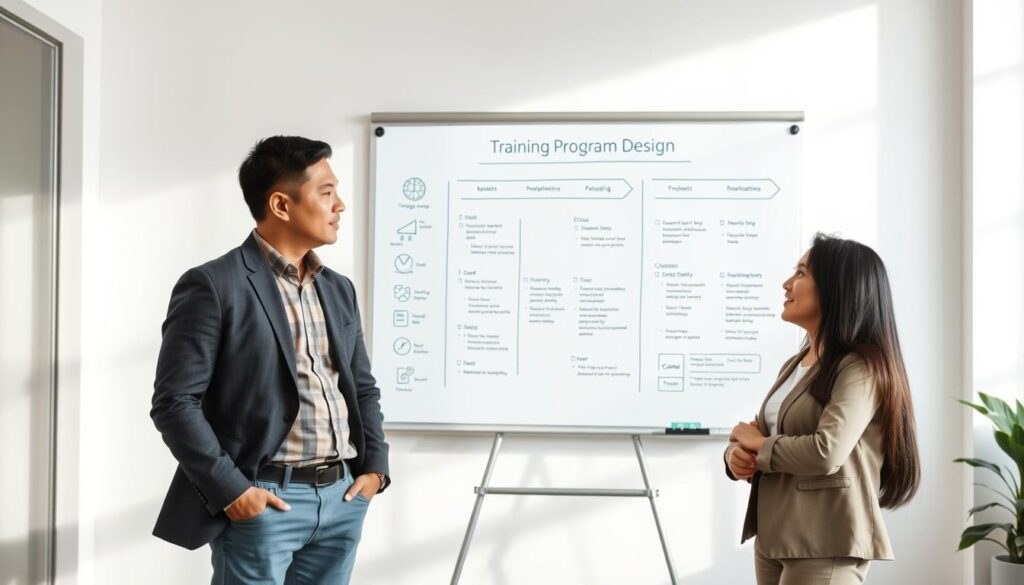Creating successful employee training programs is key for any business to succeed today. These programs not only improve employee skills but also boost productivity and job satisfaction. This leads to fewer employees leaving their jobs.
In the fast-changing Philippine business world, training programs must match company goals. They should also encourage ongoing improvement. With good planning and execution, training can be a major success factor.
Key Takeaways
- Importance of aligning training with business goals.
- Continuous evaluation is essential for effective training.
- Effective programs lead to improved employee retention.
- Skill enhancement directly impacts productivity.
- Cultural integration fosters a learning environment.
Understanding the Importance of Employee Training Programs
Employee training programs are key to boosting workers’ skills and knowledge. They help improve productivity. By investing in training, companies can meet changing market needs and keep employees happy.
Training leads to better performance, fewer mistakes, and higher job retention. It makes employees more skilled for their jobs. In the Philippines, small and medium businesses see big gains from training their staff. This boosts efficiency, competitiveness, and morale.
Identifying Business Goals for Your Employee Training Program
Setting goals for an employee training program is key to success. It involves getting insights from stakeholders, checking performance, and finding areas for improvement. Aligning training goals with business objectives makes sure the training is both relevant and effective.
Defining Clear Objectives
Using the SMART criteria helps set clear training goals. For instance, a goal might be to boost customer satisfaction by a certain percent or cut down on downtime. These goals are crucial for aligning training with business needs, even in competitive markets like the Philippines.
Conducting a Training Needs Assessment
A thorough training needs assessment is essential. It looks at current skills and knowledge gaps. This helps tailor training to meet specific needs. Engaging employees in this process can reveal their unique training requirements. For more on creating a training plan that fits your business goals, see this effective employee training plan resource.

Analyzing Employee Skill Gaps and Aligning with Organizational Objectives
Effective employee training starts with knowing the skills gaps in the workforce. By using data from reviews, surveys, and exit interviews, we can shape our training. This way, training meets both employee and employer needs.
Utilizing Data Points for Current Skills Assessment
Assessing current skills requires a detailed approach. Companies use various sources to check employee skills. For example:
- Performance Reviews: Regular checks show strengths and weaknesses.
- Employee Surveys: They give insights into what employees think they need to learn.
- Exit Interviews: Feedback from those leaving can uncover skill gaps we didn’t know about.
Creating a Skill Gaps Matrix
After collecting data, we create a skill gaps matrix. This tool helps us see where skills are lacking. It guides our training to meet business goals. Using this matrix keeps us competitive, even in changing markets.
| Skill Area | Current Skill Level | Required Skill Level | Gap | Action Required |
|---|---|---|---|---|
| Project Management | Intermediate | Advanced | High | Enroll in management training |
| Data Analysis | Basic | Intermediate | Medium | Conduct workshops |
| Technical Skills | Advanced | Expert | Low | Provide specialized training |
By analyzing skill gaps and aligning training with goals, companies can build a skilled workforce. This approach boosts both individual and company performance.
Designing a Training Program for Employees
Creating a good training program needs careful thought. It must meet the needs of both employees and the company. A strong program includes interesting and relevant content that matches business goals.
Setting clear learning goals is key. These goals help shape the training and ensure it meets expectations.
Choosing the right training methods is crucial. You can use classroom teaching, online courses, or on-the-job training. A mix of these can be very effective. It lets employees learn in different ways, helping them remember and apply what they’ve learned.
The culture of the workplace is also important. For Filipino employees, using local examples makes training more relatable and engaging. This approach helps create a positive work environment and improves training outcomes.

Creating a Robust Employee Training Action Plan
A good employee training plan is like a roadmap. It helps guide the whole training process. First, you need to check what resources you need for success. This includes finding the right trainers, technology, and materials for learning.
Incorporating Different Instructional Methods
Using different teaching methods is key to reaching all employees. You can use e-learning, workshops, and mentorship. This makes learning more fun and helps people remember what they learn.
Assessing Resource Requirements
Knowing what resources you need for training is very important. You have to think about many things, like:
| Resource Type | Description | Examples |
|---|---|---|
| Trainers | Qualified professionals who deliver training sessions. | Industry experts, experienced personnel. |
| Technology | Tools that support training delivery and engagement. | LMS, web conferencing tools, interactive software. |
| Materials | Resources used for imparting knowledge and skills. | Handbooks, online courses, visual aids. |
Your training plan should be able to change. This lets you keep up with new things and what employees say. Being able to adapt makes your training more useful and effective.
Implementing Your Employee Training Initiatives
Starting your employee training is a big step. It needs careful planning and action. Make a training schedule that fits with your company’s goals and your team’s free time. This way, training won’t mess up your daily work.
Getting people involved in training is crucial. Use fun and hands-on activities to keep things lively. Role-playing, group talks, and projects make learning fun and interactive. Also, check how well the training is going to see if you need more resources.
It’s important to keep track of how well your training is doing. Ask for feedback at the start to make the training better. This way, everyone learns what they need to know to help the company grow.

| Implementation Step | Description | Importance |
|---|---|---|
| Schedule Alignment | Coordinate training dates with organizational demands. | Prevents operational disruptions. |
| Engagement Tactics | Use interactive methods to stimulate participation. | Increases learning retention and satisfaction. |
| Progress Tracking | Monitor attendee progress throughout the program. | Identifies areas for improvement. |
| Feedback Collection | Gather participant insights post-training. | Enhances future training quality. |
Fostering Engagement During the Training Process
Getting employees to engage in training is key to success. It’s important to show them how training benefits them. Celebrating their achievements boosts their sense of pride.
Letting employees help design the training makes them more invested. When they feel included, they learn more and work better together.
Motivating Employees to Participate
There are many ways to get employees excited about training. For example:
- Highlighting career advancement opportunities linked to skills acquisition.
- Creating a platform for employees to share their achievements.
- Offering incentives such as bonuses or recognitions for completion of training.
These methods help employees see the value in training. They become more active and eager to learn.
Utilizing Interactive Techniques
Interactive training makes learning fun. It includes:
- Quizzes that test knowledge in real time.
- Role-playing scenarios to simulate real-world situations.
- Gamified elements that promote friendly competition among peers.
These methods keep learners interested and help them remember more. Interactive training boosts their enthusiasm and retention.
Using both motivation and interactive strategies creates a strong training culture. Engaged employees apply what they learn, making the training worthwhile.
Evaluating and Optimizing Your Employee Training Strategy
After starting your employee training program, it’s key to keep checking its success. This means using different ways to see if the training is working. By looking at Key Performance Indicators (KPIs), you can tell if the training is hitting its marks.
Seeing how well the training is doing helps you know what to fix. This way, you can make the program better for everyone.
Using KPIs to Measure Effectiveness
KPIs like how well people remember what they learned, if they change their ways, and how happy they are with the training are very important. By watching these, you can see where you need to get better. You can also set goals for these KPIs to see if you’re getting closer to what you want.
When you see these goals being met, it means your training is working well. This is a sign that your efforts are paying off.
Gathering Stakeholder Feedback
What people who took the training and others think about it is also very important. Asking them through surveys or interviews can give you great feedback. This feedback helps make the training better by matching it with what employees and the company need.
By using KPIs and feedback together, you can make a strong plan to keep improving your training. This way, you can make sure your training is always getting better.

Leveraging Technology in Training Programs
In today’s fast-paced workplace, technology is key to better training programs. Modern tools make learning more fun and effective for employees. Learning management systems are a big part of this change.
Utilizing Learning Management Systems (LMS)
Learning management systems are a central hub for training. They help track progress and manage learner engagement. This technology makes learning materials consistent and easy to manage.
With features like progress tracking, companies can see how employees are doing. They can also spot areas where more help is needed.
Incorporating AI Solutions for Personalization
Artificial intelligence is changing how we learn. AI solutions create learning paths that fit each employee’s needs. These paths adjust to how fast or slow the learner is.
This personalized learning boosts understanding and retention. It helps employees grasp material more deeply.
Best Practices for Employee Training Programs
It’s key to have good employee training programs for a productive team. Always look for ways to make training better and more fun. Update your materials often to keep up with new trends and what your team likes.
Continuous Improvement Strategies
Improvement never stops in a good training program. Check your training often to see if it’s working. Use what your team says to make your training better and fill in any knowledge gaps.
Ensuring Content Relevance and Engagement
To keep your team interested, mix up how you teach. Try simulations, group talks, and real-life examples. This makes learning stick better. Also, make sure what you’re teaching is still current and what your team wants to learn.
| Training Method | Strengths | Considerations |
|---|---|---|
| Simulations | Realistic scenarios enhance practical skills. | Requires investment in technology and setup. |
| Peer Discussions | Encourages collaboration and diverse insights. | Facilitation skills are crucial for productivity. |
| Real-world Applications | Directly applicable to job tasks, reinforcing learning. | Needs careful planning to ensure contextual relevance. |
Examples of Successful Employee Training Programs
Successful training programs are a guide for other companies to improve their employees’ skills and performance. Google and IBM are great examples. They show how training can lead to innovation and growth. Their programs not only fill skill gaps but also prepare for future challenges.
These companies are dedicated to ongoing learning and adapting. They set a high standard for training.
Highlighting Companies that Excel
Many companies have set the bar high for training. Global brands focus on skills and learning cultures. They use workshops, mentorship, and hands-on experiences.
This ensures employees learn both theory and practice. By using different teaching methods, these companies keep their training engaging and effective.
Case Studies from the Philippines
In the Philippines, local businesses are leading the way in training. Many Filipino SMEs use new strategies like mentoring and digital learning. These help them build a skilled workforce.
By focusing on employee growth, these companies boost individual and team performance. This trend looks promising for the future of training in the Philippines.
The Benefits of Effective Employee Training
Investing in employee training brings big wins for companies. One key perk is better productivity. When employees know their stuff, they do their jobs faster and better. This boosts business success and makes customers happy.
Training also makes employees happier at work. When they feel good about their skills, they’re more confident. This leads to a happier team and a better work place.
Training also helps keep employees from leaving. When workers feel valued, they stick around. This saves money and keeps important knowledge in the company.
Training makes a team ready for change. Companies that keep learning stay ahead. This is crucial in places like the Philippines, where the market is always moving.
| Benefits of Employee Training | Advantages of Training Programs |
|---|---|
| Enhanced Productivity | Improved Job Satisfaction |
| Reduced Turnover Rates | Increased Employee Loyalty |
| Rapid Adaptation to Industry Changes | Better Compliance and Risk Management |
| Long-term Organizational Growth | Stronger Competitive Position |
Challenges in Designing a Successful Training Program
Creating effective training faces many challenges for organizations. One big issue is figuring out what training employees really need. Without detailed assessments and clear feedback, it’s hard to know exactly what to teach.
Getting everyone to be engaged in learning is another problem. People learn in different ways, making it tough to keep everyone motivated. This makes it hard to find a training method that works for everyone.
Another challenge is finding the right balance between training and work. In busy places, it’s easy for training to get pushed aside. Using a clear plan helps keep training relevant and useful. Changing training methods can make learning better for everyone.
Keeping an eye on how well training is working is key. Regular checks help make sure training is effective. With a flexible and feedback-based approach, these challenges can become chances for growth.
Conclusion
A well-designed employee training program is key to improving both employee skills and company performance. It’s important to make sure training matches the company’s goals and creates a fun learning space. This way, companies can grow their skills and build a culture that values learning and new ideas.
For small and medium-sized businesses in the Philippines, training is a smart investment. It helps them stay ahead by having a flexible and skilled team. By focusing on training, companies can achieve greatness and succeed for a long time.

